

Classic buses in Australia, page 1 (by Dick Gilbert)
Last updated 31 October 2022
SOME LINKS WITHIN THIS WEBSITE: Home Email Links THE COMPLETE WEBSITE MENU Events Diary Halfcab list Small-Ads Classic Irish Buses Classic Manx Buses
These pages form a scrapbook of material about British buses in Australia.
The other pages are Australian buses page 2, Australian buses page 3 and Melbourne (MTT) OPS4/1 Tigers.
Please feel free to send any suitable items and I will be happy to post them.
There are some Australian bus links at the foot of this page.
CATTERY BUS IN TASMANIA

My old colleague Richard Haughey from Cambridge sent me this photo in August 2022. It is believed that this is former Sydney DRT and T 2305, a 1949 Titan OPD2/1 / Commonwealth Engineering H62D from the same batch as 2308 shown below. It wears an old black rego plate showing Northern Territory 106.328, which suggests that it went there when retired from Sydney. NT used five white numbers on a black plate from 1953, increasing to six digits in the 1970s, and white plates from 1979. That ties in neatly with Richard's report of a very faded registration expiry notice in the cab window dated 1978.
Anyway at some point after that it moved south to Tasmania, as that's where Richard came across it in October 2019, in use as a cattery! Thanks very much to Richard for the photo and the information.
THE TWICE AS NICE CHARITY COFFEE BUS

In 2007 Lorie Norton acquired former Sydney Leyland OPD2 Titan no. 2308 and set about converting it to living accommodation and a mobile coffee shop called Twice as Nice. After years of work the bus was ready to roll and he started travelling around the country raising funds for families with sick children.
A You Tube video describing the conversion is here and there is also a Facebook page with more details of the project.
UNIQUE DOUBLE DECKER CONVERSION SURVIVOR
Here's a very rare beast, brought to my attention by Peter Berry in May 2021.

Peter said; "This bus was originally one of 45 Leyland Titan TD5c double deckers acquired by Melbourne in 1939/40. Black and White buses of Sandgate, Queensland, purchased seven of them from MMTB in the late 1950s and they discarded the lower decks, lengthened the chassis and bodied them as single deckers utilising the upper decks and parts of the discarded lower decks because they were now longer. They were also retro-fitted with standard 4-speed manual gearboxes. In the photo the front wheels are the giveaway. One only is now saved. I don't have a chassis number or former fleet number for this bus, but I'm doing an article on it for the Historic Commercial Vehicle Club of Australia's magazine, The Monitor, of which I am Editor. This bus is now under restoration by the Queensland Omnibus and Coach Society Inc."
Shortly afterwards Ian Lynas sent me a whole lot of information about these buses. Ian explained that the 45 Leyland TD5s were numbered 201 to 245 with chassis numbers 302541 (no. 245) and 302542 to 302585 for all the rest, but not in numerical order. In fact nobody seems to know which chassis number matches with which fleet number, apart from 302571 which was 222. The bus in Peter's photo is chassis 302563, but that's all we know. Ian explained that the 45 Leyland Titans had bodies by the following bodybuilders:
201 to 215 by Cheetham & Borwick of Carlton, Victoria
216 to 230 by Martin and King of Malvern, Victoria
231 to 240 by J. A. Lawton and Sons of Royal Park, Adelaide, South Australia (Lawton's were to build 231 to 244 but advised the M and MTB that they were unable to complete the last four.)
241 and 242 by Cheetham and Borwick
243 and 244 by Martin and King.
Below is a picture of Melbourne MMTTB no. 203 in its original form with a Cheetham and Borwick double- deck body.

The photo above of 203 was taken in the 1950s by the late Leon Manny, formerly the manager of Jannali-Como Bus Service in southern Sydney. Leon was a prolific photographer of buses and trams from the 1950s into the 1970s.
The majority of M and MTB's Leyland Titan TD5s were withdrawn on 18 January 1954 coinciding with the opening of the Bourke Street electric tram lines. A group of fifteen had been withdrawn earlier and were sold in July and December 1953 The remainder were stored at the rear of Preston Tramway workshops until sale in 1954 and 1955.
Going back to the bus in the picture that started all this, here is its history as recounted by Ian Lynas:
"Rebuilt at Black and White (Sandgate) Buses, Sandgate, QLD using the lower deck of a TD5c and full- front (MBA-style) body built by Black and White in their workshops. Entered service June 1955 as No. 27, Q669-164, Qt/p 0778, FB43F. Heavily rebuilt by Black and White and re-registered in 1959 to NIJ.569, retaining Qt/p 0778. Remained in service until 1974. Sold to the area west of Toowoomba around Dalby for unknown use. Obviously not used, as it remained in B and W S livery with most of the seating. Around 2000 it was transported to Haden, north of Toowoomba and put into a shed with the intention of being converted to a caravan. Work did not proceed and the owner phoned the Queensland Omnibus & Coach Society in 2018. A visit resulted in the bus being started and driven and an agreement to purchase, but the owner then reneged on the deal. The bus was then advertised on Gumtree in 8/18 but was still on the property in 2019. It was a good candidate for preservation as an example of the buses operated by Black and White Sandgate from the mid-1950s through to their demise in 1974. It had a Black and White Sandgate Buses body plate, showing that it was rebuilt in 1959.
The bus has now been transported to Bundaberg where initial restoration involving cleaning and replacing windows will take place. It is historic even as a single decker because it has carried its second body for over 65 years. Incidentally MBA-style refers to the Sydney bodybuilder Motor Body Assemblers. The McGrath family who owned Black and White were originally from Armidale in New South Wales and had dealt with MBA prior to coming to Queensland. They used MBA jigs and designs for the front of their rebodies, but there were also one or two MBA-bodied buses new to the fleet."

Ian also kindly sent me his only photo (above) of no. 27 (and 29) at the Black and White depot, near the end of its days with the company on 26 May 1974. In the centre is another Leyland - an OPS4 Tiger - also formerly with the Melbourne and Metropolitan Tramways Board as their no. 343 (c/n 490894), but in the partial livery of Eastern Suburbs Omnibus Service (ESOS) of Elsternwick, Melbourne (as their no. 49 from 1957 to 1973) from whom it was purchased by Black and White in 1973.
As for known survivors;
MMTB 207 is now part of the Sydney Tramway Museum collection.
MMTB 211 is now stored with engine at St Arnaud, VIC.
MMTB 222 was panelled over making it look like a trolleybus and was last noted, derelict, on the Murray River, downstream of Mildura in 2004.
MMTB 226 (probably) stored at Drouin, VIC for preservation.
MMTB 245 was at Coleambally, NSW by 2004.
There may be other survivors, but their identities are not established. That is all a remarkable story. My thanks to Peter and Ian, and I'll try to keep track of progress with the restoration.
SOME FORMER LONDON BUSES IN AUSTRALIA
Scott Mitchell kindly sent me these pictures in March 2021 of former London Transport buses still active in Australia. First of all here is RT1787.
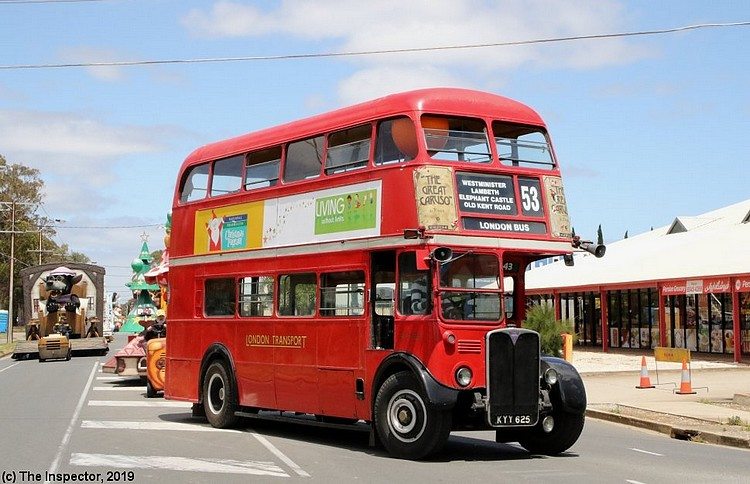
RT1787 (KYY 625) lives in Adelaide (imported in 1973) and only comes out once a year to participate in the annual Adelaide Christmas Pageant. Here we see it returning to its home at Ferryden Park in 2019.
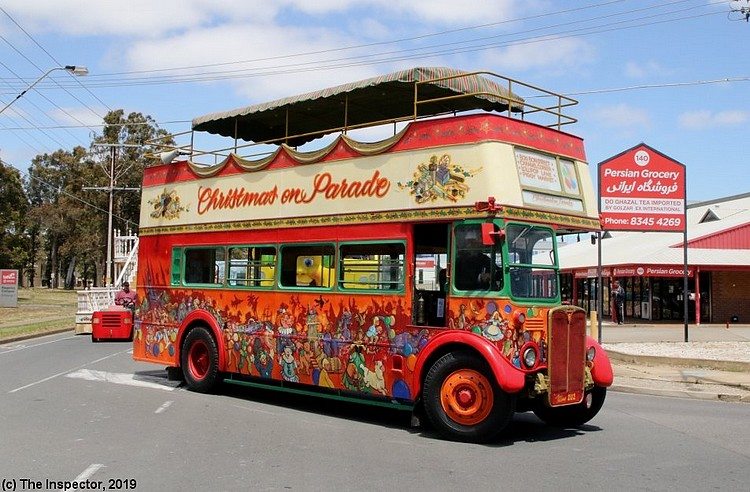
The story for RT2474 (KXW 103), which also came to Australia in 1973, is the same as for RT1787 above, except that it has been converted to open top. Once again we see it returning to its home at Ferryden Park in 2019.
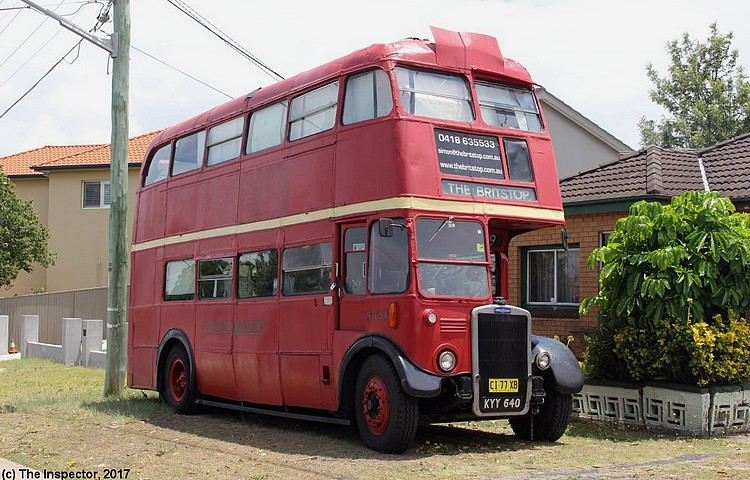
RTL 547 (KYY 640) came to Australia in 1969. Scott says "Here is a photo of poor old London Transport RTL547 which is living on borrowed time. She is no longer in use as a tour vehicle doing pub crawls, parties or other charters in Sydney, but is now a mobile accommodation unit. You can hire the bus to use as accommodation however you cannot drive it - the owner will drive it to where you want it then collect it when you are finished. The bodywork is deteriorating rather rapidly and will eventually fall apart. The photo shows it in 2017, parked up and in use as accommodation on the side of a street in a Sydney suburb."
Derek Cheng kindly sent me a picture of the same bus back in 2004 (see the bottom of this page) at the old Sydney Bus Museum (Tempe), when it was in much better condition. In October 2022 Michael Haug reported seeing it parked on a side street in the Sydney suburb of Helensburgh NSW. It looked pretty similar to the photo above, apart from a Union Jack painted on those flaps on the front roof.
The weblink shown in the destination window (thebritstop.com.au) doesn't work any more, but it seems that it used to be registered to Simon and Collette at The Britstop Party Bus, 79 Parraweena Road, Caringbah NSW 2229.
Thanks very much to Scott for his fine photos.
A BUNCH OF OLD POMS
Amid a torrent of great pictures sent to me by Scott Mitchell in February 2021, here is a selection of classic former British buses still active in Australia in the 21st century. First of all, this is former United Welsh 1 (NCY 627), a 1956 Bristol LS5G with an ECW C39F body.
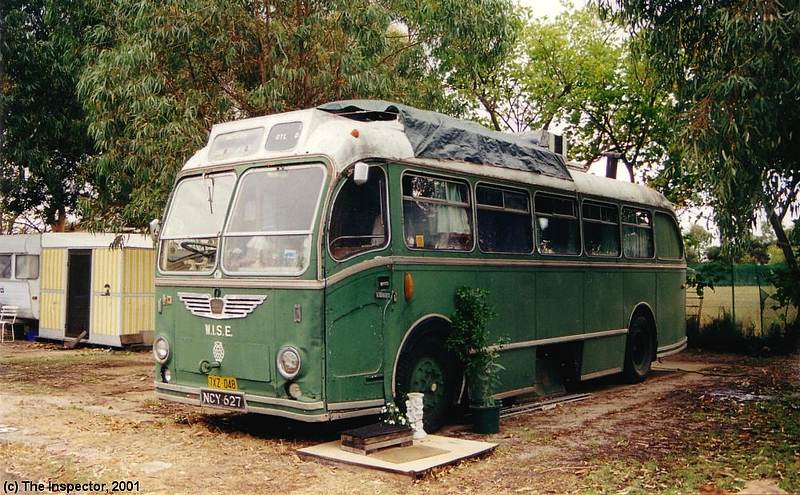
Scott saw it in a caravan park in Midland, Western Australia, in February 2001. Below is another old Brit. This is former City of Oxford AEC Renown number 362 (DFC 362D).
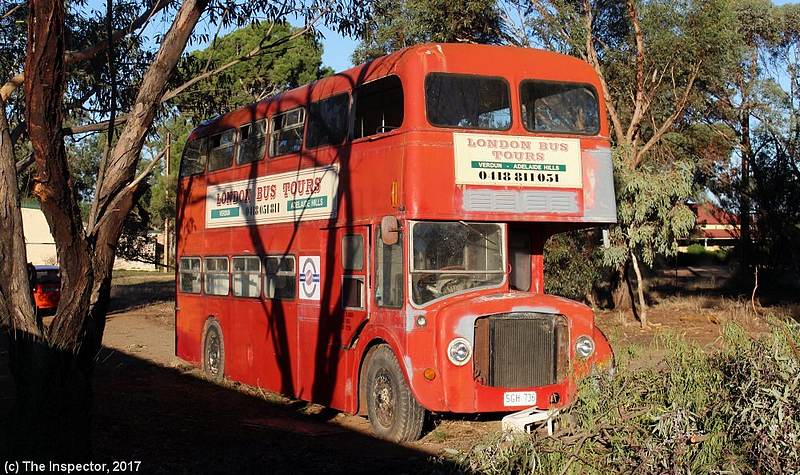
Previously with Lewis Bros of Adelaide, it is seen here in May 2017 sitting derelict on private property in Lochiel, South Australia. Finally, below we have a trio of old British and Irish buses working for Banksia Tours Big Night Out, seen at their depot yard in Port Adelaide, South Australia in January 2017. They were in use for night club tours.
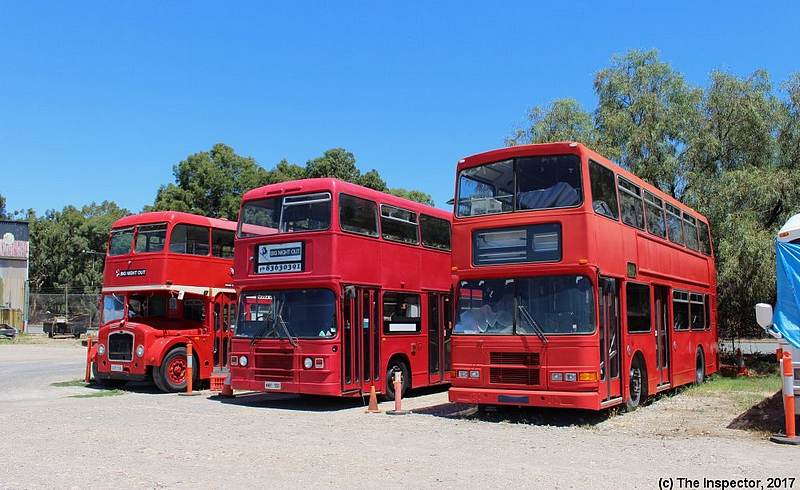
The buses, from left to right are: Western National Bristol FLF6G Lodekka no. 1993 (139 HUO), new in 1962, arriving in Australia around 1982; Stagecoach Selkent Leyland ONLXB/1RH Olympian no. L68 (C68 CHM), new in 1986, arriving in Australia in 2003, and Dublin Bus Volvo OLY-50 Olympian no. RV431 (98-D-20431) with an Alexander body, new in 1998, arriving in Australia around 2011.
Scott says that, at the time of writing, all are up for sale. Many thanks to Scott for the photos.
THREE MYSTERIES

Scott Mitchell sent me a whole load of interesting material in February 2021, including these three pictures which pose more questions than answers. The photo above shows a former MTT Adelaide Sunbeam MF2B trolleybus, seen in 2017. Scott explained "In outback South Australia along the old Ghan railway near Maree there is the Mutonia Sculpture Park, containing sculptures made from scrap. One of the exhibits is this ex Adelaide Sunbeam trolleybus known as the Ghan Hover-Bus Service. The bus rests across a small culvert that was part of the old Ghan railway. Unfortunately there are no identifying marks on it to see what MTT fleet number it was." Any suggestions?

Next we have an unidentified former Melbourne M and MTB AEC Regal III seen in a truck sales yard in Port Wakefield, South Australia in June 2013. Can anybody provide an identity for Timeless (VND.467)?

The bus in Scott's third picture clearly originates from DRTT Sydney. He spotted it in Two Wells, north of Adelaide in June 2018. Currently registered SHV.725, he says it's a Leyland, and it's certainly in better condition that some others appearing on this website! Once again, can anyone propose an identity? And thanks very much to Scott for the photos.
MELBOURNE BOBTAIL IS STILL ON THE ROAD

Adrian Probert contacted me in January 2021 to say that he was looking for a coach differential for his Regal, to give it a bit more speed on the open road. He said "It currently has a bus diff which makes it very slow on our long long highways!". He attached the picture above, and I had to know more.

It turned out to be Melbourne M and MTB 512, a 1952 AEC Regal III that originally had a Commonwealth Engineering 42-seat body, but was later shortened to a 32-seat bobtail. The photo above shows the bus when Adrian first acquired it.

And this is the view from inside. Over the driver's shoulder the number 512 can be seen, which confirms its identity. Thanks very much to Adrian for sending the pictures and good luck in the hunt for a new diff!
ANOTHER SYDNEY SURVIVOR

Here is a great picture of DRTT Leyland OPD1 Titan 1770 at Kingsgrove Bus Depot during its service life in Sydney. It was sent to me in December 2020 by Jason Connell who knows quite a bit about the bus, and for good reason - it now belongs to him! Here is what he told me:
"The bus was commissioned on Christmas Eve, 1946 in Sydney. It was sold after its retirement and relocated to McCafferty's bus company in Toowoomba, Queensland, where it saw out its days in service. After this it was sold and sat in a yard in Bogantugan, Queensland, and then purchased by an owner who planned on making it an iconic highway coffee shop, but the council wouldn't approve this so it just sat in his yard for years until I recently purchased it. The bus was advertised on Gumtree. I plan to restore it, but I'm a total newbie and only bought it to fulfill a long sentimental desire to own a bus similar to what I remember travelling on as a schoolboy. I now face the task of relocating it to my home at Ballina, north eastern New South Wales - a distance of 1000km. I'm thinking of going to check it over in the hope that I might drive it."

"It is quite rough, but apparently complete and the engine is running. The bus is currently in heavily weathered, faded condition, still wearing its McCafferty's livery. I hope to return it to limited service, mixed-use between personal and light charter activity. I am hoping to acquire as much OPD1 related information including operation and maintenance documents as possible, and being a total newcomer to this I'm open to all information as I didn't understand that I had purchased such a significant vehicle."
Thanks to Jason for the news and photos, and let's hope the restoration goes well.
A GREAT COLLECTION OF CLASSICS

Albion Venturer m/o 813 when still in service with Campbelltown Bus Service.
David Fairless of Oxford Falls NSW kindly contacted me in September 2020 to tell me about buses he has owned, or still owns. He said "I currently have three buses that started their chassis lives in the UK, the first being a 1934 Albion Venturer M80." It was one of a batch of five purchased in 1934 for use in Sydney by the Department of Road Transport and Tramways, and which originally had wooden-framed Waddington highbridge 56-seat bodies. This was no. 204 in the fleet, registered as m/o 1404, and later m/o 1204. It was sold in 1949 to an independent operator in Wollongong, being re-registered as m/o 3833 and is now fitted with a 1937 lowbridge double-deck body which, David says, is the only Australian-built lowbridge body left.

He adds "It was sold in the mid 1950s to Campbelltown Bus Service where it acquired the registration m/o 813 before sale to a country operator in the town of Casino and another change to m/o 4709. I bought the bus in 1970 and it is still an unfinished project." It was Campbelltown Bus Service who swapped the body from the original 1934 Waddington highbridge to the lowbridge example taken from 1937 DRTT Leyland TD5 m/o 1611, later renumbered m/o 1411. Above is a picture of the work in progress in David's premises at Oxford Falls.

David also has the chassis of this former Sydney 1936 Leyland TD4 (above). It originally had a double- deck body, but this had to be removed as it was in a very derelict state, although the chassis and motor is fine. DRTT acquired 35 Leyland TD4 buses between 1935 and 1937, along with seven TD4c examples with torque-converter transmission. This one was first registered as m/o 1444, then becoming m/o 1244. David says "The picture was taken as an official photo when in 1937 the Department of Road Transport and Tramways started the first government bus service across the Sydney Harbour Bridge. Two buses were specially decorated for the ceremony, an AEC Regent double decker and my TD4 which, on this special occasion, carried the workers who built the bridge and their families."

Here is the TD4 again (above), in David's yard, before the body was removed. Only the engine and chassis now remain for use as spare parts.

Seen above in St Ives, this bus is also from David's collection. Its chassis came from a 1938 Sydney Leyland TD5 double-decker originally registered m/o 1688, later becoming m/o 1488. This was acquired by Pymble St. Ives Bus Services, run by the Gillott family in the Sydney suburbs. They removed its original lowbridge double-deck body, lengthened the chassis and replaced it with a single-deck 49-seat body made by Commonwealth Engineering.
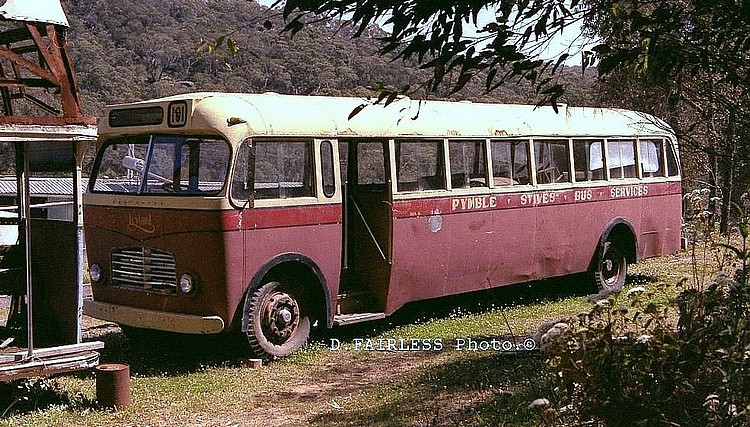
Seen after David preserved it, the bus is now registered m/o 4473.
David adds "These are not the only buses I have owned and sold over the years, as I also had an American 1926 White which I bought as a total wreck for 1 dollar (although mechanically it was all still there), had it rebuilt and then donated it to the Sydney Bus Museum." He also had a 1956 Flxible Clipper which had come from Pioneer Tours, and this 1964 Leyland Royal Tiger Cub (below). He says "It was originally owned by the Pymble - St. Ives Bus Service as their no. 22 and for a short period by Forest Coach Lines Pty. It was first registered as m/o 4872, then m/o 5417 and later as m/o 937. The photo (below, at St. Ives Showground) is at one of many displays I took it to whilst I owned it."

Many thanks to David for the photos and information, and good luck with his projects!
LONG LOST MELBOURNE TIGER TURNS UP
In October 2019 Ashlee Williams wrote to say that she'd acquired a Leyland Tiger along with some railway carriages, and wondered if the bus's identity could be established. Here it is, stored at Ballarat, Victoria, photographed by Ashlee.

It took a lot or reseach and peering into various nooks and crannies around the bus, but eventually we figured out which one it is. It's a Leyland OPS4/1 Tiger (chassis number 490980), built in 1950 and fitted with a Commonwealth Engineering 41-seat dual-entrance body, it became no. 334 in the Melbourne M and MTB fleet, registered as ET 334. In 1957 it was one of seven sold to Eastern Suburbs Omnibus Service (ESOS), an independent operator in Melbourne, and became their no. 53, registered GRV 862.
There is then a period of mystery (the dark ages) until Ashlee Williams bought it in Littlehampton, Victoria, later moving it to Ballarat. It still shows evidence of the ESOS gold, red and white livery and the discovery of its chassis plate in April 2020 established the identity beyond doubt. A great discovery - there is only one other survivor from the seven ESOS buses, no. 54 with the Victorian Bus Preservation Association. My thanks to Ashlee for letting me know about it and here's a picture by Colin Davison of identical no. 54 when in service with ESOS.

SOME PICTURES FROM MOUNT ISA
In February 2020 Peter Roberts kindly sent me a couple of pictures from his home in Mount Isa, Queensland.

The first one shows his 1963 Ansair camper back in 2015. Peter said "As far as I know the Ansair was originally built on a Thames chassis with a Ford V8 engine, and ran the Melbourne to Bendigo route. It was later fitted with a UD4 2-stroke diesel. In private life it was fitted out as a motorhome before being rescued from a paddock near Proserpine and refitted out again. I sold it to a Victorian man and I understand it is now back in Victoria."

The second picture shows yet another former Sydney bus (an AEC Regent, although it doesn't look like one) with Peter's grand-daughter in 2012. The bus was fitted out as a motorhome and toured Australia at a very low speed. It ended up in Mount Isa about 30 years ago and became the residence of the caretaker at the Restored Car Club. He left town many years ago and didn't return for the bus, so it is now derelict and used for storing car parts.
Thanks to Peter for the interesting pictures. In April 2020 Ian Lynas sent me lots more information about this bus:
"The double decker is former Sydney Department of Road Transport and Tramways 681 (m/o.1681), an AEC Regent with a Waddington body of 1940. When delivered this bus was painted in the camouflage livery of swirling patches of green, brown, khaki and grey and originally with sliding panels for windows. Glass was fitted when it became available later in the War. In 1948, its fleet number was increased by 1000 to match its registration number and the DRT and T became the Department of Government Transport. 1681 was sold in August 1961 to H. T. Saint and Sons, Peakhurst, in Sydney's southern suburbs (Australia's largest Atkinson bus operator) where it became m/o.4484 and was still in service when I arrived in Australia in June 1970."

"This picture shows it at H. T. Saint's depot after a short charter on a Saturday in August 1970. It was one of the first photographs I took with my then new Topcon 35mm SLR camera. The Topcon wasn't all that flash and within a year the flip-up mirror had become detached. I managed to trade it in for a Nikkormat. I've never looked back, using Nikons to this day. Anyway back to 1681, it was driven by a guy called John Sam Brown, now deceased, to Mount Isa in north central Queensland in 1972 and converted into a caravan. It then supposedly did at least two trips around Australia before getting back to Mount Isa in the early 1980s. It was then used by the caretaker of the local Restored Car Club located opposite the Mount Isa Airport and that is where I (and a group of Sydney transport enthusiasts) found it in 2006. We also were told that the owner had left town some time before and said he would come back to fetch it when he found a suitable site for it, obviously he is still looking!"
Thanks very much for the picture and all that information Ian.
YET ANOTHER OLD SYDNEY BUS IS SPOTTED
The late Garth Wyver kindly sent me this picture in August 2019, which he described as a bus in the bush (or at least on the edge of the bush).

Garth said "I went for a walk along a fire trail this afternoon which took me past the bus. It is former Sydney Leyland Titan OPD2/1 (chassis number 511162) m/o 2673 at Ridgewell Road, Blackheath. It's in a bad state now - the windows are missing, the front mudguard has gone and it has rotted-out rear panelling."
Sydney 2673 was delivered in 1952 and was noted for sale in Cobago NSW in 2000 in poor condition. By 2015 it was spotted in Blackheath having its windows plated up, presumably as part of conversion to a mobile home. But the latest information from Garth suggests that the conversion was not completed and its future now looks bleak.
Postscript: My faithful correspondent Garth Wyver sadly passed away only three months after he took this picture. He had been sending me photos from Australia for years and we used to chat endlessly about his love of East Kent Road Car from his younger days in the U. K. I miss Garth and I'm glad that his name crops up all over this website, and will continue to do so for ever.
HONG KONG REGENT IN NSW
Ben Summers from Sydney contacted me in December 2018 to say that, while returning from a trip to the Hunter Valley he spotted this mighty AEC Regent parked down a side street in Kearsley, NSW, just west of Newcastle.

Ben said "A quick message to my friend David Wilson revealed it is an ex Kowloon Motor Bus AEC Regent V that was brought to Australia in the late eighties by Brian Blacklock for a group called the Hunter Transport Museum in Newcastle. Unfortunately the group disbanded and the vehicles went their various ways. This Regent V ended up with Shadows Wine Country Double Decker Tours of Cessnock NSW (formerly Shadows Mini-Bus Service) whose (faded) colours it still wears. It appears to be in good structural condition, and someone is obviously looking after it, as I saw several bottles of cleaning liquid and a cloth on the lower deck when I poked my head through the open centre door. Most of the seats are in place, and the bus even retains the bilingual signage from its days in Hong Kong. It has a four-speed semi-automatic gearbox."

This view shows how massive these buses are - or were, as this is reputed to be one of only three left in the world. They SEATED 84, so you can only guess what the capacity might be when Hong Kong demanded the maximum! Kowloon Motor Bus bought 210 of them with extended wheelbases (34 feet) between 1963 and 1966. This one is apparently former Kowloon number A68 (AD 4860) dating from 1964. Although it now seems to be out of use, at least it's intact, and my thanks to Ben for sending the photos.
ANOTHER OLD SYDNEY LEYLAND TITAN - UPDATED (TWICE!)
John Townsend sent me an email in October 2010 to say that he had spotted an old Sydney Leyland double decker (OPD1 or OPD2) in NSW, and it looked like this:

John says "I was in Newcastle NSW in January/February this year, and was having a run out in the car on our way to Port Stephens, when we came across an old Leyland double decker in the middle of a field in the Anna Bay area. You can see it on Google Earth. I have had no luck trying to find out its details and wondered if you have any ideas. She is sitting in a field just off the highway to Port Stephens. On talking to my son (who lives in Newcastle NSW) he seems to think the highway is called Nelson Road, Anna Bay."
Nobody has managed to identify which one it is, but John contacted me again in August 2018 with a new picture:

John said "It's still there, but not very well now, and if the grass grows any higher you won't see it at all." Thanks very much to John for sending me the photos. I doubt that we'll be seeing much more of this bus!
Then, in April 2020, Ian Lynas contacted me with the bus's identity: "This is a Leyland Titan OPD1, formerly Sydney DGT no. 1785 with a Commonwealth Engineering body. It was operated by Singleton Bus Service after its Government service and is still at Anna Bay. The Sydney Bus Museum does not have an OPD1 in their collection. There have been a few around - two (1778 and 1825) are currently located in Emmaville, northern NSW but neither is in good enough condition. Former 1821 is now derelict in Tasmania." Thanks Ian.
NOTES FROM THE SYDNEY BUS MUSEUM

The late Garth Wyver, then a volunteer at the Sydney Bus Museum, visited on 17 February 2018 but said that he "didn't do any work - spent most of the time chatting". Fortunately he also spent a bit of time taking pictures for the Classic Buses Website. This one shows an apprentice-built model of 1981 Mercedes Benz O305 no. 2516 with a PMC Mk. 3 B43D body. The original bus seems to have come to grief by falling into water. Can someone explain?

Garth said "I caught 2643 basking in the sun". This is a Sydney AEC Regent III and may be one of only two survivors of a large batch delivered in 1951-53. It wears the blue and cream PTC livery of the 1970s. In the background is the Museum's 1970 Leyland PDR1 Atlantean 1003 in the same colours."

"This is one of three Hong Kong buses hanging around but not owned by the Museum", said Garth. "They are enormous vehicles!" In fact it is ML1, the first prototype of the 12 meter, 3-axle MCW Super Metrobus to be delivered to China Motor Bus. It has a capacity of 170 passengers, which was a record high in Hong Kong at that time. It's currently preserved in Sydney and a model of it is sometimes available for sale in the Museum's shop.
Bob Gioia, Asset Manager at the Museum, kindly emailed in June 2018 to say that the ownership of ex Hong Kong ML1 has passed to the Sydney Bus Museum and it is now a permanent exhibit and part of their running fleet.
REO SPEEDWAGON FOUND IN NEW SOUTH WALES

My regular correspondent, the late Garth Wyver was visiting Hay, NSW in August 2017 and found this old Reo Speedwagon bus in a yard. New to a company in Oxley NSW (and it looks to me like a late 1940s model), it had been used as a school bus, then owned by a church, and finally a mobile home. It had no seats, and the steering wheel and column had been removed.

Although a Pepsi advert on the back is not clear in this photo, the hooks are for transporting pushchairs.
UPDATE: In February 2018 this bus was advertised on Gumtree for AUD 8,000. The seller said it dated from 1935 and had one spring missing (as well as the steering wheel). The location was shown as being just off the Cobb Highway (B75) north of Hay NSW.
ADELAIDE DAIMLER TO BE RESTORED

This picture was kindly sent to me by the late (and much missed) Garth Wyver in 2017. He used to help out at the Sydney Bus Museum and told me that next in line for restoration there was this rare and early Adelaide Daimler CVG6.
Adelaide MTT bought fifteen CVG6s in 1947/48 (numbered 112 to 126) and fitted them with Commonwealth Engineering highbridge dual-entrance bodies. Unlike the majority of U. K. domestic sales of the CVG6, most exported chassis were eight feet wide, and that's the case with the Adelaide batch. In 1960/61 twelve of them were transferred to Transway in the northern Adelaide suburb of Elizabeth, where they lasted about another 10 years. But the other (first) three of the original batch didn't go that way, and no. 112 (c/n 13319, new in April 1947) remains as the sole survivor.
Garth also sent me a page from the original maintenance record for this bus dating back to 1947. It reveals that it arrived overland from Sydney on 30 May 1947, was put into traffic on 30 May 1947 and was involved in a serious collision in 1949.
Apparently it has been wearing the registration 224.663 (instead of 224.662) which actually belongs to no. 119, but I'm sure the Museum will put that right as they restore the bus back to its original Adelaide red and silver livery. There are believed to be only three remaining Adelaide double deckers, so it's an important relic and certainly the one in the best condition.
RESTORATION OF A MELBOURNE 1912 DAIMLER

Melbourne Daimler CC no. 21 in service around a century ago.
Malcolm Nixon contacted me from Wagga Wagga in February 2017 to let me know about a 1912 Daimler CC that Nixons Engineering had restored. Malcolm says "Its origins were as a vehicle imported to Australia by the Melbourne Motor Omnibus Company. The Daimler company built approximately 560 units of the CC bus chassis between 1912 to 1914. This restored vehicle is chassis number CC-9. There are only two known Daimler CC buses in the world - this one located in Wagga Wagga and one in England that is missing its engine."

Melbourne Motor Omnibus Daimler CC no. 1 restored by Nixon Engineering
Malcolm continues "Production of the CC chassis stopped when war was declared with the Daimler factory ramping up production of the CB model which had a longer 13 ft wheelbase and a heavier chassis for a 4 tonne truck. Features of the Daimler CC bus include:
Timber frame chassis with steel flitch plates each side, hot riveted.
Daimler 4 cylinder sleeve valve engine.
Daimler 3 speed roller chain drive gearbox (which reduced noise for bus passengers).
Front Tyres 34" x 4" single solid rubber.
Rear Tyres 36" x 9" dual solid rubber.
In Australia, this is the oldest restored British-built commercial vehicle on the road."
My thanks to Malcolm for sending me the information and pictures, and congratulations to Nixons Wagga for producing such a fabulous restoration.
See also Australian buses page 2, Australian buses page 3 and Melbourne (MTT) OPS4/1 Tigers.
SOME LINKS WITHIN THIS WEBSITE: Home Email Links THE COMPLETE WEBSITE MENU Events Diary Halfcab list Small-Ads Classic Irish Buses Classic Manx Buses